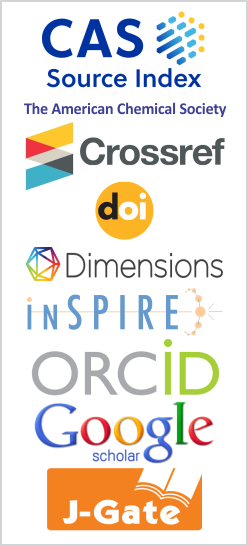Lifetime Measurement of Highly Charged Ions Relevant to Astrophysics
DOI:
https://doi.org/10.26713/jamcnp.v2i2.334Keywords:
X-rays, atomic data, Atomic processes, Line, formationAbstract
We have measured the \(\rm 1s2s2p ~^4P^0_{5/2}\)-\(\rm 1s^22s~^2S_{1/2}\) magnetic quadrupole X-ray transition energy in Li-like Fe along with the \(\rm 1s2s~^3S_1\)-\(\rm 1s^2~^1S_0\) transition energy in He-like Fe using multi channel doppler tuned spectrometer. These states have been produced through the interaction of 165 MeV Fe\(^{12+}\) ion beam with 100 \(\mu\)g/cm\(^2\) thin carbon foil. Further we have measured the lifetime of \(\rm 1s2s2p ~^4P^0_{5/2}\) level in Li-like Fe. The measured transition energy of \(\rm 1s2s~^3S_1\)-\(\rm 1s^2~^1S_0\) is in good agreement with the available theoretical predictions and experimental measurements, whereas the measurement of \(\rm 1s2s2p ~^4P^0_{5/2}\)-\(\rm 1s^22s~^2S_{1/2}\) energy is little lower than the theoretical estimations. However, the measured lifetime of \(\rm 1s2s2p ~^4P^0_{5/2}\) level compares well with the theoretical predictions.Downloads
References
P. J. Serlemitsos et al., ApJ 184 (1973), L1.
N. E. White, A. Peacock and B. G. Taylor, ApJ 296 (1985), 475.
F. J. Seely, U. Feldman and I. U. Safronova, ApJ 304 (1986), 838.
N. E. White et al., ApJ 301 (1986), 362.
M. P. Ulmar, ApJ 319 (1987), 118.
A. C. Fabian and I. M. George (1991), in Iron Line Diagnostics in X-ray sources (Lecture Notes in
Physics), eds: A. Treves, G. C. Perola and L. Stella (Berlin: Springer-Verlag), 169.
H. Gould, R. Marrus and P. J. Mohr, Phys. Rev. Lett. 33 (1974), 676.
M. Bitter et al., Phys. Rev. Lett. 42 (1979), 304.
M. Bitter et al., Phys. Rev. Lett. 47 (1981), 921.
P. Beiersdorfer et al., ApJ 409 (1993) 846.
J. I. Pietenpol, Phys. Rev. Lett. 07 (1961), 64.
I. A. Sellin, D. J. Pegg and P. M. Griffin, Phys Rev Lett. 28 (1972), 1229.
T. Nandi et al., Phys. Rev. A 66 (2002), 1052510.
P. Beiersdorfer et al., Phys. Rev. A 66 (2002), 032504.
T. Nandi, N. Ahmad and A. Wani, Phys. Rev. A 7 (2005), 022711.
R. K. Karn et al., Rev. of Sci. Instrum. 85 (2014), 066108.
A. H. Gabriel, Mon. Not. R. Astron. Soc. 160 (1972), 99.
H. G. Berry, Rep. Prog. Phys. 40 (1977), 155–217.
D. Kanjilal et al., Nucl. Instru. Methods A 328 (1993), 97.
J. P. Rozet et al., Nucl. Instr. Meth. B 107 (1996), 67.
http://physics.nist.gov/cgi-bin/ASD/lines.ph
T. Nandi, Astrophys. J. Lett. 673 (2008), L103.
http://physics.nist.gov/PhysRefData/XrayMassCoef/tab3.html
F. Ziegler and J. P. Bierssek, http://www.srim.org
C. L. Cocke et al., Phys. Rev. A 9 (1974), 57.
M. Bitter et al., Phys. Rev. Lett. 43 (1979), 129.
M. H. Chen, B. Crasemann and H. Mark, Phys. Rev. A 24 (1981), 1852.
T. Kato et al., At. Data Nucl. Data Tables 67 (1997), 225.
M. A. Bautista et al., Astronomy & Astrophysics 403 (2003), 339.
K. Cheng, C. Lin and W. R. Johnson, Phys. Lett. A 48 (1974), 437.
Downloads
Published
How to Cite
Issue
Section
License
Authors who publish with this journal agree to the following terms:- Authors retain copyright and grant the journal right of first publication with the work simultaneously licensed under a CCAL that allows others to share the work with an acknowledgement of the work's authorship and initial publication in this journal.
- Authors are able to enter into separate, additional contractual arrangements for the non-exclusive distribution of the journal's published version of the work (e.g., post it to an institutional repository or publish it in a book), with an acknowledgement of its initial publication in this journal.
- Authors are permitted and encouraged to post their work online (e.g., in institutional repositories or on their website) prior to and during the submission process, as it can lead to productive exchanges, as well as earlier and greater citation of published work.




